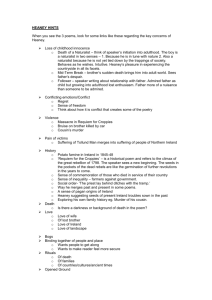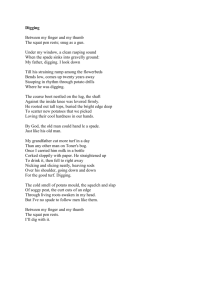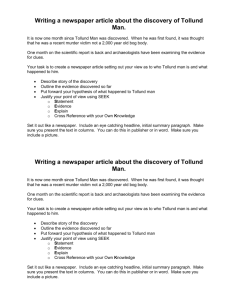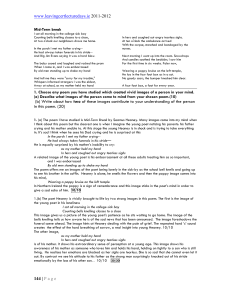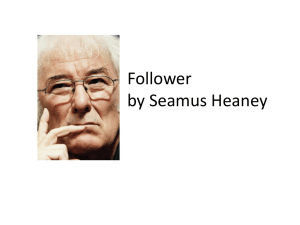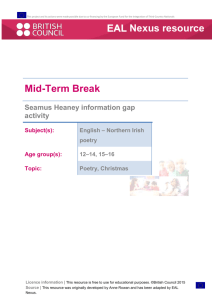The Tollund Man – Seamus Heaney
advertisement
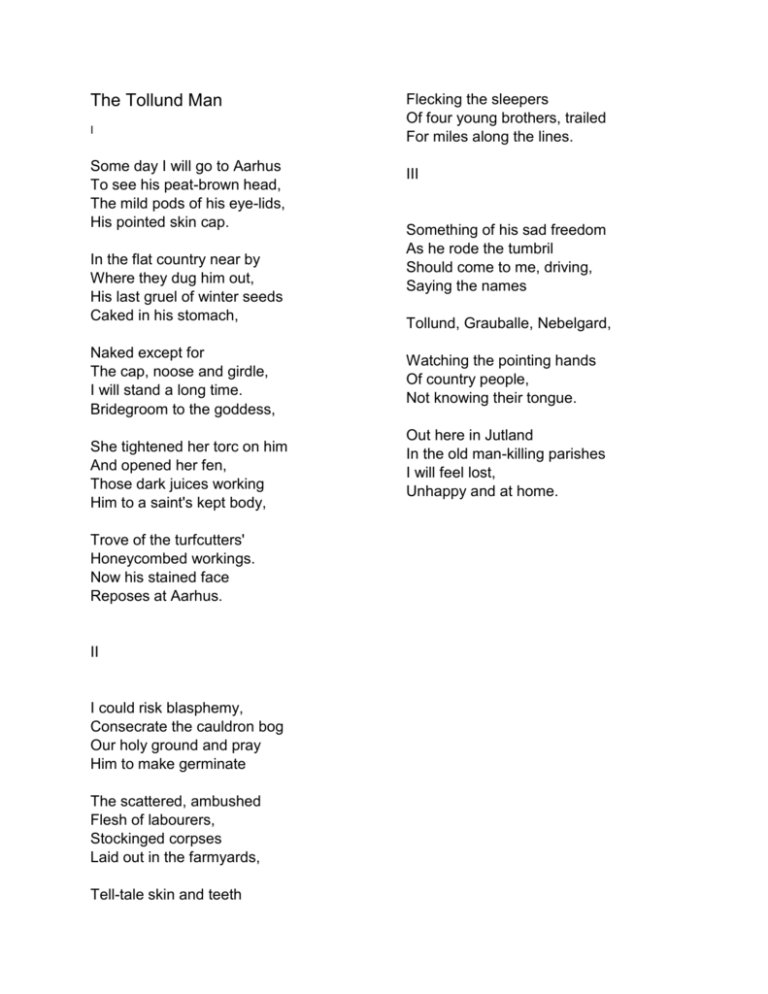
The Tollund Man I Some day I will go to Aarhus To see his peat-brown head, The mild pods of his eye-lids, His pointed skin cap. In the flat country near by Where they dug him out, His last gruel of winter seeds Caked in his stomach, Naked except for The cap, noose and girdle, I will stand a long time. Bridegroom to the goddess, She tightened her torc on him And opened her fen, Those dark juices working Him to a saint's kept body, Trove of the turfcutters' Honeycombed workings. Now his stained face Reposes at Aarhus. II I could risk blasphemy, Consecrate the cauldron bog Our holy ground and pray Him to make germinate The scattered, ambushed Flesh of labourers, Stockinged corpses Laid out in the farmyards, Tell-tale skin and teeth Flecking the sleepers Of four young brothers, trailed For miles along the lines. III Something of his sad freedom As he rode the tumbril Should come to me, driving, Saying the names Tollund, Grauballe, Nebelgard, Watching the pointing hands Of country people, Not knowing their tongue. Out here in Jutland In the old man-killing parishes I will feel lost, Unhappy and at home. Story. Heaney wants to go to Demark to see the wizened remains of the bog-body at Aarhus. He was executed with his last meal still in his stomach. He wants to worship him, against all religious constraints. He wants to call upon his to raise the dead Irish. He wants to derive a sort of power from the body, from the country, from being alone. Structure. The poem is divided into eleven stanzas, and three parts. The first part has five stanzas, and the second and third three. The first part of the poem is a description of what Heaney will see when he views the body. The second part is the relationship between the religious sacrifice and the dead Irish, and the third Heaney in the country of Denmark. There is little rhyme (although Heaney uses end of line assonance occasionally), but there is a singsong rhythm in the up and down of the vowel sounds, despite Heaney's use of enjambment. in the future tense - with a sense of a perhaps, a distant. Heaney never wanders in his conviction that he will go, and he will do exactly this and that, but it is not a trip he is contemplating with urgency. It is a "Some day" poem. Tone. The opening tone of the first part is "mild" Heaney will passively "see", and "stand for a long time", the meticulous observer. The description of the primitive "goddess" to whom the man was sacrificed makes the tone more ominous, more fateful. She "tighten[s]", "work[s]", and only away form her can he "repose". Heaney's tone is more emphatic in the second part, his verbs and language becomes stronger. He "could risk", "consecrate", "pray". His voice is doomladen. The tone of the last stanza is mournful. "Freedom" is "sad", a man who is "a home" must also be "lost,/Unhappy". He is passive, accepting. Mood. Language. Heaney makes a point of the place-names he uses in "The Tollund Man" - "Aarhus", "Tollund", "Graubelle", "Nebelgard", "Jutland". The language used to describe the body is quite impersonal - "his peat brown head", "a saint's kept body". He tries to emphasise the body's quasi-divinity. Diction. The poem has a first person persona, an "I". The Tollund Man is never named except in the title, it is only "he". Despite this, the bog is personified as "she", the divine worship of the primitives takes on the same identity as the people themselves. The poem is narrated The opening of the poem is expectant, determined - "Some day I will", and respectful, he intends to "stand for a long time" in the presence of the dead, the "bridegroom to the goddess". There is a sense of powerlessness on the part of the corpse, of larger forces drawing him along. He is consumed by the "torc" and "fen" of the "goddess". He is then left to chance, to the "turfcutters'/Honeycombed workings". He becomes anguished in the second part, calling upon words such as "blasphemy" to describe his impotent longings obliterate the wrongs of the past. In the third part the Heaney-persona feels quiet despair, quiet strength, "sad freedom". Poetic Devices. Alliteration - "peat... pods... pointed", "tightened... torc", "trove... turfcutters" "blasphemy... bog", "consecrate... cauldron", "tell-tale... teeth... trailed", "something... sad... should... saying", "pointing... people" Assonance - "Aarhus... head", "mild... lids", "bridegroom... goddess", "torc on", "honeycombed workings", "cauldron... pray", "ambushed/Flesh", "teeth... sleepers", "miles... lines". Figures of Speech. preservation making him their saint. His paradoxical survival and "repose" should give him the power to raise the others. Heaney's primary use of Denmark (and foreignness) as imagery is in the third part. The isolation from society is emphasised by dwelling on the strange names "Tollund, Graubelle, Nebelgard,", "not knowing their tongue". The "at home" is not supposed to be comforting, it is just the persona's normal state. He is always "lost,/Unhappy". But at the same time, the isolation from language gives a "sad freedom", too highly priced. Theme. Metaphor - "a saint's kept body" Imagery. The first image is that of the corpse, who is quiet and impersonal, the poem's victim of fate, caught in the "torc" of others. He is "mild", and everything is done to him. He is "dug... out", "worked", left as a "trove". He is exposed - "naked", and finally he sleeps. He is described in a wizened state, careful emphasis made on his brown skin, the workings of the fen. He is destroyed and yet elevated at the same time. There is a bleak, harsh feeling associated with the surrounding country, the "cauldron bog", the "tumbril". They are the "old mankilling parishes", the larger for which the smaller is sacrificed. The "goddess" is part of the country - it absorbs and strangles, alone or destroyed at will. The only marks it leaves on its victims are the remains of their death "cap, noose and girdle". The first victim of fate is extended to the others, "the scattered, ambushed/Flesh of labourers", of victims "trailed/For miles along the lines." Their fellow in the Tollund Man should be somehow spiritually akin, his The poem is about the forces of fate, the chance survival of the bog body, the "saint's kept body", against the "scattered... flesh of labourers". But even the body was tied to religious forces out of his sphere. In "The Tollund Man", freedom is bought at a high price, that of being "lost/Unhappy". There is no society, no group, merely cold death, and outside forces. https://files.puzzling.org/wayback/hsc/heane y
